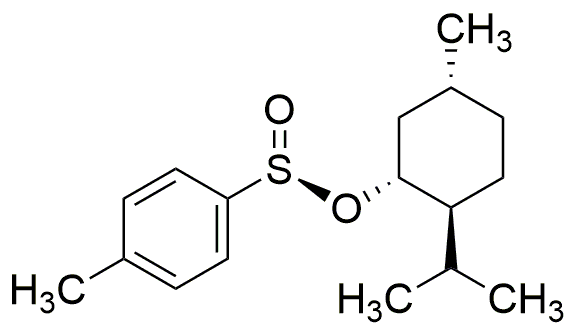(1R,2S,5R)-(-)-Menthyl (S)-p-toluenesulfinate is widely utilized in research focused on:
- Flavor and Fragrance Industry: This compound is often used as a flavoring agent in food products and as a fragrance component in cosmetics, providing a minty aroma that enhances sensory experiences.
- Pharmaceutical Applications: It serves as an intermediate in the synthesis of various pharmaceuticals, contributing to the development of medications with improved efficacy and reduced side effects.
- Agricultural Chemistry: The compound is explored for its potential as a pesticide or herbicide, offering a more environmentally friendly alternative to traditional chemicals in pest management.
- Research in Organic Synthesis: It is utilized in organic synthesis as a chiral auxiliary, aiding chemists in creating enantiomerically pure compounds, which are crucial in drug development.
- Perfume Formulation: Its unique properties allow it to be a key ingredient in high-end perfumes, where it contributes to the complexity and depth of fragrance profiles.
Informations générales
Propriétés
Sécurité et réglementation
Applications
(1R,2S,5R)-(-)-Menthyl (S)-p-toluenesulfinate is widely utilized in research focused on:
- Flavor and Fragrance Industry: This compound is often used as a flavoring agent in food products and as a fragrance component in cosmetics, providing a minty aroma that enhances sensory experiences.
- Pharmaceutical Applications: It serves as an intermediate in the synthesis of various pharmaceuticals, contributing to the development of medications with improved efficacy and reduced side effects.
- Agricultural Chemistry: The compound is explored for its potential as a pesticide or herbicide, offering a more environmentally friendly alternative to traditional chemicals in pest management.
- Research in Organic Synthesis: It is utilized in organic synthesis as a chiral auxiliary, aiding chemists in creating enantiomerically pure compounds, which are crucial in drug development.
- Perfume Formulation: Its unique properties allow it to be a key ingredient in high-end perfumes, where it contributes to the complexity and depth of fragrance profiles.
Documents
Fiches de données de sécurité (FDS)
La FDS fournit des informations de sécurité complètes sur la manipulation, le stockage et l’élimination du produit.
Spécifications du produit (PS)
Le PS fournit une description complète des propriétés du produit, notamment sa composition chimique, son état physique, sa pureté et les exigences de stockage. Il détaille également les plages de qualité acceptables et les applications prévues du produit.
Certificats d'analyse (COA)
Recherchez des certificats d'analyse (COA) en saisissant le numéro de lot du produit. Les numéros de lot et de lot se trouvent sur l'étiquette d'un produit, après les mots « Lot » ou « Lot de fabrication ».
Numéro de catalogue
Numéro de lot/série
Certificats d'origine (COO)
Ce certificat d'exploitation confirme le pays dans lequel le produit a été fabriqué, et détaille également les matériaux et composants utilisés et s'il est issu de sources naturelles, synthétiques ou autres sources spécifiques. Ce certificat peut être requis pour les douanes, le commerce et la conformité réglementaire.
Numéro de catalogue
Numéro de lot/série
Fiches de données de sécurité (FDS)
La FDS fournit des informations de sécurité complètes sur la manipulation, le stockage et l’élimination du produit.
DownloadSpécifications du produit (PS)
Le PS fournit une description complète des propriétés du produit, notamment sa composition chimique, son état physique, sa pureté et les exigences de stockage. Il détaille également les plages de qualité acceptables et les applications prévues du produit.
DownloadCertificats d'analyse (COA)
Recherchez des certificats d'analyse (COA) en saisissant le numéro de lot du produit. Les numéros de lot et de lot se trouvent sur l'étiquette d'un produit, après les mots « Lot » ou « Lot de fabrication ».
Numéro de catalogue
Numéro de lot/série
Certificats d'origine (COO)
Ce certificat d'exploitation confirme le pays dans lequel le produit a été fabriqué, et détaille également les matériaux et composants utilisés et s'il est issu de sources naturelles, synthétiques ou autres sources spécifiques. Ce certificat peut être requis pour les douanes, le commerce et la conformité réglementaire.


